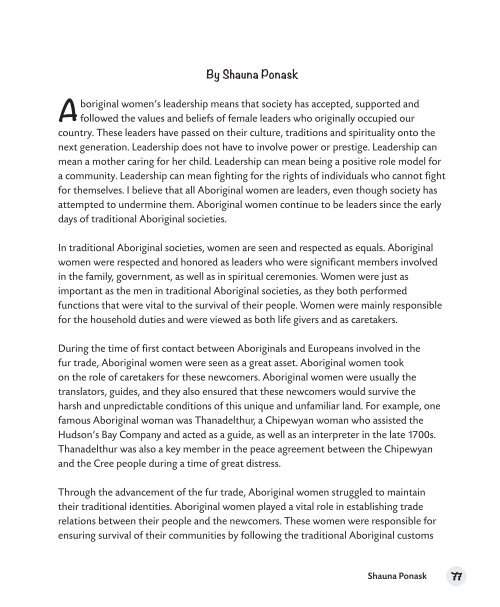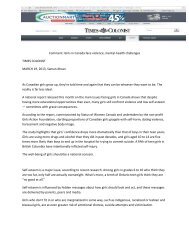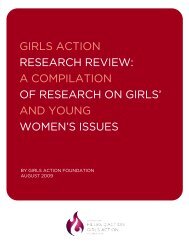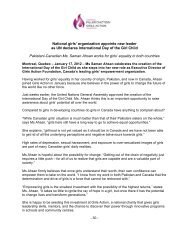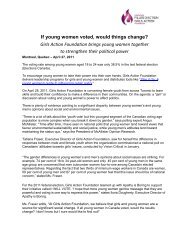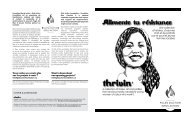Aboriginal - Girls Action Foundation
Aboriginal - Girls Action Foundation
Aboriginal - Girls Action Foundation
Create successful ePaper yourself
Turn your PDF publications into a flip-book with our unique Google optimized e-Paper software.
By Shauna Ponask<br />
<strong>Aboriginal</strong> women’s leadership means that society has accepted, supported and<br />
followed the values and beliefs of female leaders who originally occupied our<br />
country. These leaders have passed on their culture, traditions and spirituality onto the<br />
next generation. Leadership does not have to involve power or prestige. Leadership can<br />
mean a mother caring for her child. Leadership can mean being a positive role model for<br />
a community. Leadership can mean fighting for the rights of individuals who cannot fight<br />
for themselves. I believe that all <strong>Aboriginal</strong> women are leaders, even though society has<br />
attempted to undermine them. <strong>Aboriginal</strong> women continue to be leaders since the early<br />
days of traditional <strong>Aboriginal</strong> societies.<br />
In traditional <strong>Aboriginal</strong> societies, women are seen and respected as equals. <strong>Aboriginal</strong><br />
women were respected and honored as leaders who were significant members involved<br />
in the family, government, as well as in spiritual ceremonies. Women were just as<br />
important as the men in traditional <strong>Aboriginal</strong> societies, as they both performed<br />
functions that were vital to the survival of their people. Women were mainly responsible<br />
for the household duties and were viewed as both life givers and as caretakers.<br />
During the time of first contact between <strong>Aboriginal</strong>s and Europeans involved in the<br />
fur trade, <strong>Aboriginal</strong> women were seen as a great asset. <strong>Aboriginal</strong> women took<br />
on the role of caretakers for these newcomers. <strong>Aboriginal</strong> women were usually the<br />
translators, guides, and they also ensured that these newcomers would survive the<br />
harsh and unpredictable conditions of this unique and unfamiliar land. For example, one<br />
famous <strong>Aboriginal</strong> woman was Thanadelthur, a Chipewyan woman who assisted the<br />
Hudson’s Bay Company and acted as a guide, as well as an interpreter in the late 1700s.<br />
Thanadelthur was also a key member in the peace agreement between the Chipewyan<br />
and the Cree people during a time of great distress.<br />
Through the advancement of the fur trade, <strong>Aboriginal</strong> women struggled to maintain<br />
their traditional identities. <strong>Aboriginal</strong> women played a vital role in establishing trade<br />
relations between their people and the newcomers. These women were responsible for<br />
ensuring survival of their communities by following the traditional <strong>Aboriginal</strong> customs<br />
Shauna Ponask<br />
77


